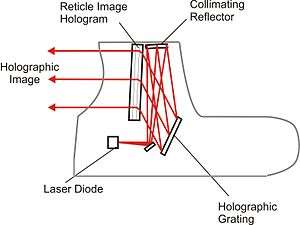EOTech
 | |
| Subsidiary of L-3 Communications | |
| Industry | optics |
| Founded | 1995 |
| Founder | Richard Palermo, Anthony Tai, Van Donohue, Eric Sieczka |
| Headquarters | Ann Arbor, Michigan, U.S. |
Area served | Worldwide |
Key people | Anthony Tai |
| Products | holographic and close quarters battle firearm sights, riflescopes |
| Parent | L-3 Communications (acquired EoTech in 2005) |
| Website | http://www.eotech-inc.com |


EOTech designs, manufactures, and markets electro-optic products and systems. The company is headquartered in Ann Arbor, Michigan. They produce holographic weapon sights for small arms that have been adopted by various military and law enforcement agencies as close quarters battle firearm sights.
They also have roots in the Environmental Research Institute of Michigan (ERIM), a non-profit R&D institute. Of the many inventions by ERIM researchers, some were in the fields of synthetic aperture radar, laser holography, and aircraft head-up displays.
Products
As of 2012, EOTech primarily manufactures holographic weapon sights. EOTech was the first company to create these types of sights,[1] having solved the problem of wavelength instability exhibited by laser diodes. They developed achromatic holographic optics that compensate for any change in the emission wavelength of the laser diode with temperature.[2][3][4] The sights are designed to be mounted on small arms via a MIL-STD-1913 Picatinny or Weaver rail, and powered by either AA, N or CR123 size batteries for up to 1,100 hours of runtime. Sights display either a 65 MoA ring with a 1 MoA dot in the center, a single 1 MoA dot, a vertical series of dots for bullet drop compensation in certain calibers, or, in the case of their less-lethal sights, a flared vase-like sight to assist in the aiming of bean-bag or rubber ball rounds commonly used in riot control. Bushnell marketed the non-military versions under the brand name "Holosight". The EOTech 553 is in U.S. military service under the designation SU-231/PEQ and M553 in the commercial market. More recently, the U.S. Military is also purchasing and issuing the newer EOTech EXPS3 model, designated the SU-231A/PEQ. A specialty sight for the grenade launcher has also been accepted by the U.S. military with the designation SU-253/PEQ. Their first holographic sight was introduced in January 1996.
An archery sight was discontinued in November 2004, in line with the company's desire to concentrate on military and law-enforcement products.
In 2015 the US Government sued EOTech for civil fraud, accusing it of covering up defects in the sights that it knew about as early as 2006. The first defect was "thermal drift", which causes the aiming point to shift in high or low temperatures by as much as 12" at 300 yards. The second was "moisture incursion" or "reticle fade", which causes the viewing glass to fog up and the aiming point to lose brightness.[5] EOTech settled for $25.6 million, and fixed the "moisture incursion" defect. However, as of April 2016 it reported that it could not cure the thermal drift defect. Thousands of EOTech sights are used by federal law enforcement and military, including special forces.[6]
Technology
Unlike reflector sights, the holographic weapon sight does not use a reflected reticle system. Instead a representative reticle is recorded in three-dimensional space onto holographic film that is part of the optical viewing window. Like the reflector sight, the holographic sight's reticle uses collimated light and therefore has an aim-point that can move with eye position. This is compensated for by having a holographic image that is set at a finite distance, in this case around 100 yards. The sight's parallax due to eye movement is the size of the optical window at close range and diminishes to zero at the set distance.[7]
To compensate for any change in the laser wavelength, the EOTech sight employs a holography grating that disperses the laser light by an equal amount but in the opposite direction as the hologram forming the aiming reticle. The result is a reticle that is stable with the change in temperature.
One requirement of holographic projection is a laser. Lasers use more power and more complex driving electronics than an LED of an equivalent brightness, reducing the amount of time a holographic sight can run on a single set of batteries.
See also
References
- ↑ Jane's international defense review: IDR.: Volume 34, page 76
- ↑ "HOLOgraphic Weapon Sight Product Introduction" NDIA/EOTech presentation, June 2004.
- ↑ "Compact Holographic Sight", Patent #5,483,362 issued January 9, 1996.
- ↑ "Light Weight Holographic Sight", Patent #6,490,060 issued December 3, 2002
- ↑ http://www.military.com/daily-news/2016/01/21/eotech-breaks-silence-over-defective-sights.html
- ↑ https://www.washingtonpost.com/news/checkpoint/wp/2016/04/03/u-s-special-operations-units-are-using-faulty-rifle-sights/
- ↑ ar15.com " Parrallax on an Eotech?" - Tech support question - Parallax issues with 550 series- "The sights do have parallax error of +/- 1.2 " or +/- 0.6" (1.2 " side to side). The sight is designed to be parallax free at long distance 100yds to infinity. At close range, there will be a parallax error equaling to the width of the window which is 33mm or 1.3". A perfectly aligned sight will have parallax error of 1.3" at 10 yds and at 17 ft. As you move further away from 10 to 40 yards parallax becomes less and is almost zero at 50 yards."
External links
- EOTech Company Website
- Reference on holography
- "USSOCOM Issues Safety of Use Message for EOTech Enhanced Combat Optical Sights – Plus More Goings On" Soldier Systems Daily September 30, 2015